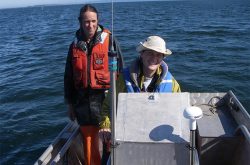
By area, tidal flats make up more than 50 percent of Willapa Bay in southwest Washington state, making this more than 142-square-mile estuary an ideal location for oyster farming. On some parts of these flats, oysters grow well, filling their shells with delicacies for discerning diners. But according to experienced oyster farmers, oysters raised in other parts of Willapa Bay don’t yield as much meat.
Now, scientists may have an explanation for this variability. In a paper published online July 26 in the journal Estuarine, Coastal and Shelf Science, researchers at the University of Washington and the University of Strathclyde report that the water washing over the Willapa Bay tidal flats during high tides is largely the same water that washed over the flats during the previous high tide. This “old” water has not been mixed in with “new” water from deeper parts of the bay or the open Pacific Ocean, and has different chemical and biological properties, such as lower levels of food for creatures within the tide flats.
“Previously, there had been this belief that when water drains off of tide flats or out of a bay, currents and wind mix that water up,” said lead author Eli Wheat, a UW instructor in the College of the Environment who conducted this study as a doctoral student in the UW Department of Biology. “It turns out that this is not necessarily true. It takes multiple tidal cycles for this mixing to occur.”
The research was funded by a National Oceanic and Atmospheric Administration grant to Washington Sea Grant at the University of Washington.
Read more at UW News »
